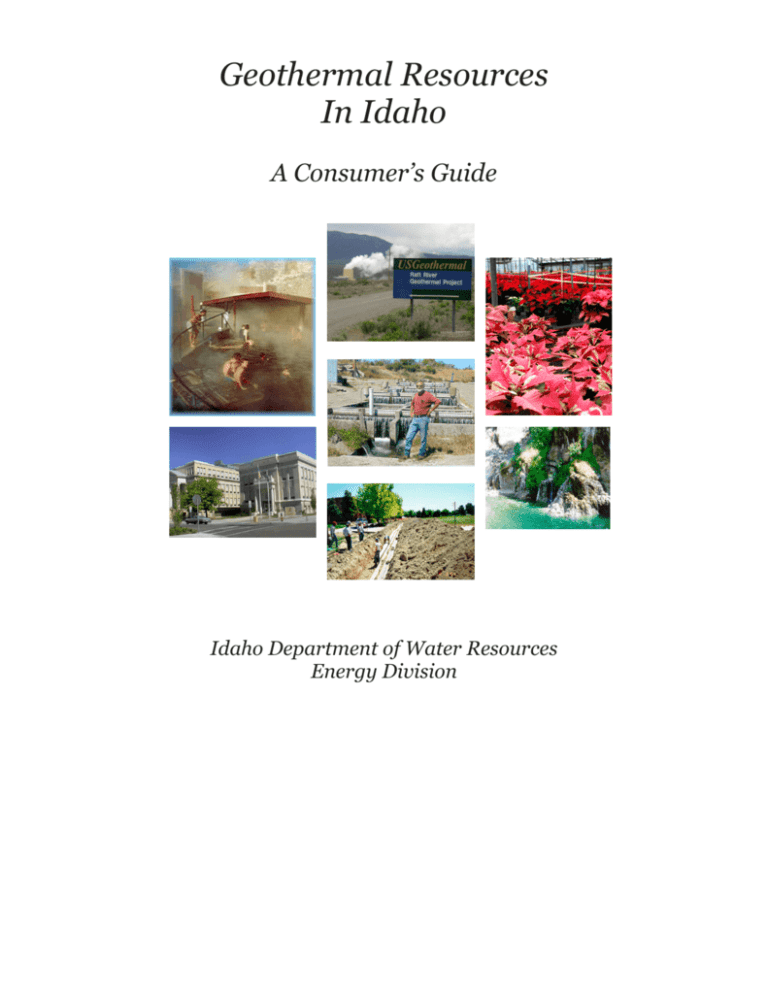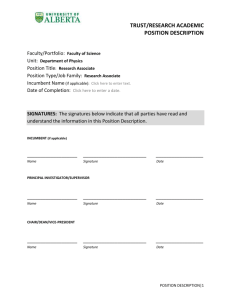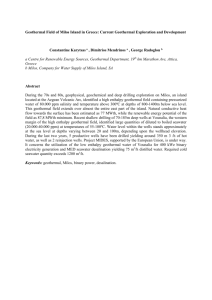Geothermal Resources In Idaho
advertisement

Geothermal Resources In Idaho A Consumer’s Guide Idaho Department of Water Resources Energy Division Originally published in 2003 by Helen Harrington, Ken Neely and Warren Weihing Updated by Ken Neely in 2007 Idaho Department of Water Resources Energy Division 322 E. Front Street P.O. Box 83720 Boise, Idaho 83720-0098 208-287-4800 www.idahogeothermal.org Funding for this publication was provided by the U.S. Department of Energy’s GeoPowering the West Program Front Cover Photographs, from top center clockwise: Raft River Power Generation site, Edwards Greenhouse poinsettias, Brown Creek Hot Springs, College of Southern Idaho geothermal distribution system, Boise High School (which is in the City of Boise’s district heating system), Lava Hot Springs, and Leo Ray, fishbreeders of Idaho (center). Contents Page Introduction .................................................................... 1 The Why and Where of Geothermal .............................. 1 Geothermal Uses ............................................................ 5 Power Generation ........................................................... 5 Direct Use....................................................................... 7 Space Heating............................................................. 7 Aquaculture ................................................................ 9 Recreation................................................................. 10 Other Direct Uses ..................................................... 10 Some Hot Ideas on the Horizon ................................... 11 Regulatory, Environmental, and Construction Issues for Direct Use Projects ........................................... 14 References .................................................................... 17 Contacts ........................................................................ 18 Page 1 Introduction Welcome to Idaho’s geothermal story. Idaho is blessed with vast resources of geothermal water, which have been used by people for many centuries. Native Americans congregated at hot springs as indicated by artifacts and petroglyphs on nearby rocks. Hot springs were also used by settlers, miners, and trappers beginning in the mid 1800’s. In 1892, the nation’s first district heating system went “on-line” in Boise (Figure 1). Today, many wells and springs in Idaho are being used to heat hundreds of homes and buildings and to Table 1. Types of geothermal use in Idaho, and the number of wells and springs in service per use. Type of Use District Heating Small heating systems Greenhouses Aquaculture Developed Recreation Bottled Water Power Generation Total Wells1 Springs1 11 93 16 14 11 0 72 152 1 0 2 0 26 1 0 34 1 Water Temperature greater than 85° Fahrenheit (F). 2 US Geothermal, Inc plans to have these wells in operation by late 2007. Figure 1. The Natatorium was one of the first buildings in the Boise Warm Springs Water District. Photo courtesy of the Idaho Historical Society. provide heat energy to businesses, such as greenhouses, aquaculture, and recreation (Table 1). Geothermal is a proven energy resource in Idaho that has great potential for additional developments. The Why and Where of Geothermal Geothermal is heat (thermal) from the earth (geo). Geothermal water can be either trapped under the earth’s surface, or escape through hot springs, geysers, and drilled wells. On a worldwide scale, geothermal resources occur in distinct linear patterns. These bands of geothermal occurrences are often related to plate tectonics Page 2 Figure 2. The Ring of Fire is the band of earthquakes and volcanoes that rims the Pacific Ocean. Geothermal water is found along the Ring. Graphic credit: U.S. Geological Survey. which is the theory describing the movement of massive pieces of the earth’s crust. In some places, the crust has broken apart and the two pieces have pulled away from each other with new crust being formed at the junction. In other places, two slabs have collided into each other. The thin boundaries between adjacent slabs are often hundreds to thousands of miles long. Volcanoes and earthquakes are common at these plate junctions. Faults, which are breaks in the rocks, allow geothermal water to move vertically. In the Pacific region, the Ring of Fire is a collision boundary between several crustal plates (Figure 2). Some of the geothermal reservoirs associated with the Ring of Fire are up to a couple hundred miles from the plate boundaries. An example of this occurs east of the Ring of Fire throughout the western United States where evidence of extensive geothermal activity is shown by patterns of heat flow at the land surface (Figure 3). Page 3 accumulates in deep reservoirs (Figure 4). The faults also provide pathways for the hot water to move upward into shallower reservoirs, and to flow onto the land as hot springs. Figure 3. Surface heat flow in the continental United States (Source: Southern Methodist University website) Faults are common conduits that allow water to percolate into the earth where it is heated and In Idaho, basalt, rhyolite, and ash are rock types that indicate the state was once active volcanically. Geothermal developments have occurred in the central and southern parts of the state where the hot water resources are commonly at, or close to, the land surface (Figure 5). Figure 4. Water moves from the land surface down faults, is heated by the earth’s underground sources, and is stored in reservoirs at various depths. Graphics Credit: Geo-Heat Center. Page 4 Figure 5. Geothermal resources in Idaho. Graphics Credits: Idaho Department of Water Resources and Idaho National Laboratory. Page 5 Geothermal Uses The energy from geothermal water can be used in two manners: Power Generation and Direct Use. Power generation requires water temperatures of about 250° F.1 Direct Use can effectively use “low temperature” geothermal resources, which range from about 70° to 212° F (Figure 6) Table 2. Near-term (by 2015) geothermal power generation capacity for western states (Table GT-I.2 from the Western Governors’ Association Geothermal Task Force Report) Power Generation Power generation uses a technology in which turbines are driven by steam that is produced either by “flashing” very hot geothermal water, or through the use of a secondary “working” fluid that is heated by the primary geothermal water to the flashing point. Currently, the production capacity for geothermal power generation worldwide is 8,900 Megawatts (MW) (Muslin, 2006). A newly-released report ranked Idaho 3rd out of 12 western states in potential for new geothermal power generation by 2015 (Table 2; source is the Western Governors’ Association, 2006). In Idaho, U.S. Geothermal, Inc., plans to be producing electricity 1 using geothermal at the Raft River location in Cassia County, in late 2007. U.S. Geothermal’s first phase is to be a 13 MW plant (U.S. Geothermal Press Release pages). The company has plans for additional phases at Raft River with hopes that the field may have a capacity of 90 MW. In other power generation news in Idaho, IdaTherm, LLC, is working to obtain funding for exploration drilling at the China Cap and Willow Springs prospects in southeastern Idaho where power potential might be 140 MW. An exception to this requirement is United Technologies’ new method, which is in use at Chena Hot Springs, Alaska, with 165°F water (see References). Page 6 Figure 6. Geothermal uses and associated temperature ranges. Graphics Credit: Geothermal Education Office and Geo-Heat Center. Page 7 In Valley County, the initial exploration work completed by IdaTherm is being considered by the county commissioners, who hope that geothermal resources hot enough for power generation and with adequate water flow will be discovered in the area. Direct Use Direct use allows the energy in the water to be used directly in a variety of heating applications without a water-to-steam conversion (Figure 7). Figure 7. Percentage for Direct Heat Uses in the United States (Source: GeoHeat Center, 2000) Idaho has a long and successful history of direct use of geothermal with recreation and space heating being the first uses in the late 1800’s and early 1900’s. In fact, Idaho has the oldest district heating system in the US: The Boise Warm Springs Water District. Most of the geothermal developments in Idaho since the mid 1970’s (the time of the nation’s first energy crisis) have put hot water to use for space heating homes, large buildings and greenhouses, and for aquaculture. The use of geothermal water is generally dictated by the temperature and chemistry of the water. The quantity, quality, and nature of the geothermal resource may be the determining factor in how the geothermal energy can be put to use. For example, the water may not be conducive to some aquaculture operations because of the minerals contained in it. In other cases, the geothermal water may be too cool for uses such as drying food or recreation. Some geothermal water might even need to be cooled prior to using it for aquaculture and recreation. The following sections describe the primary geothermal direct uses found in Idaho. Space Heating Idaho buildings that range in size from the State Capitol and larger to trailer homes are kept warm with geothermal water. Heat exchangers, radiators, and pipes in floors are methods that distribute Page 8 and transfer the heat from geothermal water into living and work spaces. In some cases, multiple buildings are connected by distribution lines, and the result is a district heating system. Eight district heating systems are in operation in Idaho, including the oldest system in the United States – the Boise Warm Springs Water District (BWSWD) (Figure 8). In addition to the BWSWD, the state of Idaho, city of Boise, and Veterans Administration operate geothermal district heating systems in downtown Boise (Figure 9) (Neely, 1998; 2006). Figure 8. Over 200 homes and business are serviced by the Boise Warm Springs Water District. More than half of the square footage at the College of Southern Idaho (CSI), Twin Falls, is heated by a geothermal system with Figure 9. Map of the four district heating systems in the Boise area. Page 9 water temperatures just over 100° F (Neely, 1996). The Kanaka Rapids community is a district heating system in rural western Twin Falls County that uses water with a temperature similar to CSI’s for heating about 70 homes. On a smaller scale, hot water can be used effectively to heat an individual home. In some cases, heat is extracted by circulating water through pipes in flooring and in radiators. In the Castle Mountain Creek subdivision near Crouch, most homes are heated with geothermal by using a closed loop system (Figure 10). This method eliminates the need to discharge from the aquifer, which keeps water levels from declining. In addition to keeping buildings warm for people, geothermal water has proven to be a valuable resource in Idaho for space heating greenhouses (Figure 11). Bedding plants, cut flowers, and vegetables are produced using geothermal heat. There are 10 greenhouses in the state currently using geothermal water to raise plants. Geothermal heating projects for existing and new buildings are possible in many areas of Idaho. However, economic benefits must be assessed on a case-by-case basis. Figure 11. Geothermal water is used in Idaho’s greenhouse industry. Figure 10. Closed loop systems can extract heat from geothermal wells without discharging water. (Graphic source: Geo-Heat Center). Aquaculture Geothermal aquaculture – the cultivation of fish and other Page 10 aquatic creatures, and aquatic plants using geothermal water, is big business in Idaho. Catfish, tilapia, tropicals, snails, bullfrogs, coral, and alligators are being raised at 12 Idaho locations, thanks to geothermal waters that are suited to these life forms (Figure 12). In the U.S., aquaculture is the largest direct use application for geothermal energy. Aquaculture continues to show the largest increases in growth nationwide, with new and expanded operations occurring in Idaho since the early 1990s. your favorite plunge (Figure 14), Idaho offers many options for getting into hot water. In all, the state has about 200 hot springs. Thirty-four commercial or developed facilities offer a wide range of swimming and soaking pools, water slides, camping, and other recreation. Figure 13. Soothing geothermal water occurs at natural hot springs in the Idaho mountains. Figure 12. Tropical fish are one of the types of aquaculture being raised in Idaho’s geothermal water. Recreation People visit undeveloped hot springs and commercial spas and pools in Idaho to soak and relax. Whether you want to hike miles for a refreshing dip in a pristine mountain setting (Figure 13), or drive right to the parking lot of Figure 14. Gold Fork is one of the commercial hot spring pools in Idaho. Other Direct Uses Low-temperature geothermal energy can be used in a variety of commercial and industrial applications. For example, Idaho Page 11 is home to a bottled water operation whose source is geothermal water, which comes to the earth’s surface through faults. The water is 138° F when it emerges from the springs. Although not used for its thermal value, the purity and mineral content of the geothermal water is its selling point. At another Idaho location, geothermal water was once used to sterilize soil for a mushroom farm. Numerous possibilities for commercial uses of geothermal water exist in Idaho, such as fruit and vegetable drying, biofuel production, laundries, and clay drying. Some Hot Ideas on the Horizon In the last several years, interests in geothermal have been renewed in the western U.S. because of rising energy prices and the growing emphasis placed on renewable energy due to climate change concerns and the uncertainties related to oil and natural gas supplies. Since 2001, the U.S. Department of Energy’s GeoPowering the West program has played a significant role in assisting Idaho (and other western states) with resource assessments, technical studies, and the development of Geothermal Energy Teams at the local community level. Figure 15 (page 13) shows, and the following list describes, recent developments in Idaho geothermal, many of which have received, or are slated to receive, funding assistance through GeoPowering the West: 1. U.S. Geothermal – Raft River Power Generation. U.S. Geothermal is poised to complete Phase 1 of its Raft River project in Cassia County. U.S. Geothermal expects to have this 13 MW plant operating by the Fall of 2007. U.S. Geothermal is already working on plans for additional phases at Raft River; the company hopes that the geothermal field will have a capacity of 90 MW. 2. City of Boise – District Heating System. In 2006, the city added two newlyconstructed buildings to their system (the Hampton Hotel and the Idaho Banner Bank). In early 2007, the city completed its collection line, and now reinjects 100% of its spent geothermal water. Three new buildings are slated to go “on line” with geothermal heat in 2007. And, the city and Boise State University are considering Page 12 the possibility of extending the supply and collection lines to the college campus (Figure 9). 3. Valley County – Geothermal Exploration. In 2006, IdaTherm, LLC conducted a geological reconnaissance in Valley County with the goal of identifying potential sites for geothermal power generation. The report was presented to the Valley County commissioners; it currently remains confidential as the commissioners decide their next course of action. In another project, the Cascade School District began drilling a production well in June, 2007, to be used for a geothermal heat pump application for the High School. The well was originally proposed to be drilled to 600 feet deep in order to find water with a temperature of about 70° F. However, the presence of geothermal water (>than 85° F) in nearby wells and the occurrence of geological faults in the area have provided justification for drilling the well deeper. Therefore, the well depth may be extended 300 to 400 feet more in an attempt to encounter a fault that will provide geothermal water. 4. IdaTherm Prospects – Geothermal Power Exploration. IdaTherm, LLC is seeking funding for drilling exploration wells at the China Cap and Willow Springs geothermal power sites in southeast Idaho. The combined capacity of these two prospects is estimated to be 140 MW. 5. College of Southern Idaho (CSI) – Space Heating. Two deep wells (2,220 feet and 1,480 feet) provide heat to over half of the buildings on the CSI campus with water that is just slightly above 100° F (Neely, 1996). CSI is planning new construction in an area north of the present campus. The college would like to use the geothermal water to heat the new facilities, and has discussed this option with the IDWR. Currently, the college administrators are waiting for the water right licensing to be completed by the IDWR for their two production wells before proceeding with the next phase of their plans. 6. Warm Springs & Ketchum – Recreation and Heating. About 20 years ago, geothermal water from Guyer Hot Springs was used successfully to heat homes in a mountainous area that is a couple miles west of Page 13 Ketchum and close to the Warm Springs Lodge and Ski area. The community is considering a revitalization project to help boost the local economy, and part of the plan may include using geothermal water from Guyer Hot Springs for recreation and space heating. Ketchum is also interested in a geothermal heat pump application for snowmelt on the 4th Street Corridor. Currently, only about 17% of the 1,078 geothermal wells and springs in Idaho are being used for thermal applications. That leaves almost 900 wells and springs in the state with water temperatures greater than 85° F that could be used for aquaculture, greenhouses, district heating, recreation, and many other opportunities. So, if you have a hot idea for geothermal in Idaho, there are lots of proven resources, and probably many more waiting to be discovered. For additional assistance with your ideas and questions, check out the references and list of contacts at the end of this publication. Figure 15. The locations of existing geothermal projects in Idaho that are expanding or considering expansions, and the new projects that are being explored. Page 14 Regulatory, Environmental, and Construction Issues for Direct Use Projects Direct Use projects typically will have regulatory, environmental, and construction issues that need to be addressed with state and federal agencies and professional service providers (Table 3). 1. Water Development Restrictions. In Idaho, water level declines have caused the need for the restricting future developments through tools such as Ground Water Management Areas, Critical Ground Water Areas, Water Districts, and Moratoriums. Contact the Idaho Department of Water Resources to determine if an area of interest is restricted with respect to water extraction 2. Well Construction. If a geothermal well is to be drilled, stringent well construction requirements will apply because geothermal drilling is more challenging than cold water drilling. Special equipment is required for protecting both the Table 3. Contact information for geothermal regulatory and environmental issues. Issues Contact Internet Address Regulatory Water Development IDWR www.idwr.state.id.us Restrictions Well Construction IDWR www.idwr.state.id.us Water Rights IDWR www.idwr.state.id.us Land ownership IDL www2.state.id.us/lands/index.htm USDI BLM www.id.blm.gov Disposal method IDEQ www.deq.state.id.us/ (Open water – IDWR IDEQ. Subsurface www.idwr.state.id.us – IDWR) Environmental Air emissions, noise, IDEQ www.deq.state.id.us/ wildlife, culture, etc. Other Delivery system Professional Engineer Heat extraction Professional Engineer Page 15 workers and the water resources. In addition to temperature differences, geothermal water often has a different chemistry than overlying cold water reservoirs. Therefore, both the hot and cold water reservoirs must be protected from cross contamination. Contact the Idaho Department of Water Resources for well construction rules that apply to the drilling of geothermal wells and an application for permission to drill. In some cases, a test well will be a wise economic plan if the likelihood of finding the resource is risky. 3. Water Rights. The use of the geothermal water may require a water right, which gives the water right holder the legal right to divert water. In some cases, an application for a new water right will have to be completed. In other cases, an existing water right may be available. Contact the Idaho Department of Water Resources for water right information. 4. Land Ownership. Land ownership issues will need to be addressed with geothermal projects. Determine the landowner and contact the individual or agency to see if an agreement can be reached that provides access to the property and water. On federally-owned lands, contact the USDI Bureau of Land Management for more information. Contact the Idaho Department of Lands if the property is owned by the state of Idaho. 5. Disposal Method. Options for disposing the spent geothermal water include injection wells, evaporation/infiltration ponds, and discharging to surface water. Geothermal water may contain minerals and compounds, which could degrade the water quality if not disposed of properly. Discharge into surface water or injection into the ground may require permits from state agencies. Contact the Idaho Department of Environmental Quality for questions about discharging geothermal to surface waters. Injection of spent geothermal back into the subsurface through the use of a well requires a permit from the Idaho Department of Water Resources. The following Environmental issues may need to be considered with a geothermal project: • Air emissions • Noise Page 16 • • • • Land use Vegetation and wildlife Land subsidence Cultural factors Contact the Idaho Department of Environmental Quality for more information if any of these issues may be a part of the project. Other issues that need to be considered are the delivery system for the operation, and the method for extracting the heat from the production facility and the delivery system. Contact a Professional Engineer to assist with these aspects of the project. ________________________________________________________________________ Finale Curiosity (About Geothermal) Got The Cows In Owyhee County, the late Bill Young of the USGS Boise District collected a gas sample from a geothermal well under the watchful eyes of some bovine onlookers (Photo Credit: Deb Parliman, USGS - Boise) Page 17 References Chena Hot Springs, Alaska. http://www.yourownpower.com/New/ Geothermal Education Office. http://geothermal.marin.org/ Geo-Heat Center, Oregon Institute of Technology. http://geoheat.oit.edu/ Idaho Department of Water Resources Geothermal Website, 2007. www.idahogeothermal.org. Idaho National Laboratory. http://geothermal.id.doe.gov/ Muslin, Elee, 2006, Geothermal power – finally, a little respect. Griffen/Rose Equity Research – Industry Report. http://www.griffenrose.com/reports/GEOTHERMAL%20by%20GriffenRose%2010-30-06.pdf Neely, K.W., 1996, Geothermal heat keeps students warm at the College of Southern Idaho, Geothermal Resource Council Transactions, v. 20, p. 129-136. www.idahogeothermal.org Neely, K.W., 1998, Production, temperature, and water level data for the four heating systems in the Boise Front Low Temperature Geothermal Resources Area, 1977-1997. Idaho Department of Water Resources Open-File Report, 31 p. www.idahogeothermal.org Neely, K.W., 2006, Review of Boise Front Geothermal Monitoring Data for Water Year 2006. Idaho Department of Water Resources, 13 pages. www.idahogeothermal.org Southern Methodist University Geothermal Laboratory. http://www.smu.edu/geothermal/ United Technologies Company Power. http://www.utcpower.com/fs/com/bin/fs_com_Page/0,11491,0197,00.html U.S. Geological Survey. http://vulcan.wr.usgs.gov/Glossary/PlateTectonics/description_plate_tectonics.htm l U.S. Geothermal Press Release Page. http://www.usgeothermal.com/NewsReleases.aspx Page 18 Western Governors’ Association, 2006, Geothermal task force report. http://www.westgov.org/wga/initiatives/cdeac/Geothermal-summary.pdf. Contacts GeoPowering the West U.S. Department of Energy http://www1.eere.energy.gov/geothermal/gpw/ Idaho Department of Water Resources Geothermal Program 322 East Front Street P.O. Box 83720 Boise, ID 83720-0098 208-287-4800 www.idahogeothermal.org E-mail: geothermalInfo@idwr.state.id.us Intermountain West Geothermal Consortium Boise, ID http://www.geothermalresearch.org/ Geo-Heat Center Oregon Institute of Technology 3201 Campus Dr. Klamath Falls, OR 97601 Phone: (541) 885-1750 http://geoheat.oit.edu/ Geothermal Education Office 664 Hilary Drive Tiburon, CA 94920. 415-435-4574 or 800-866-4436 E-mail: geo@marin.org 4 Cost associated with this publication are available from the Idaho Department of Water Resources in accordance with Section 60-202, Idaho Code, IDWR, 6/07. PCA 33370/1500








